Nanoracks experiment poised to demonstrate metal cutting in orbitMay 24, 2022 Stephen Clark [SFN]
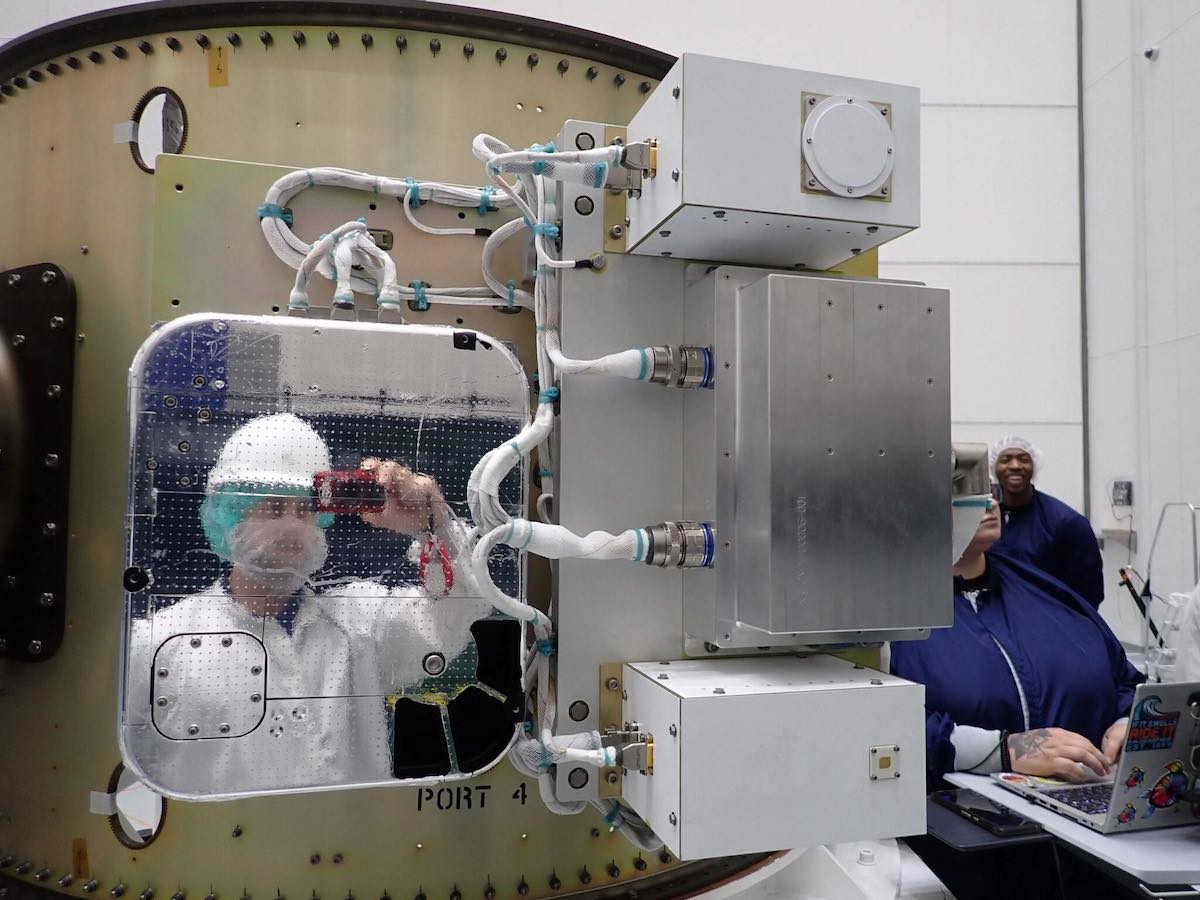 The Outpost Mars Demo-1 payload ready for launch on SpaceX’s Transporter 5 rideshare mission. Credit: Nanoracks
The Outpost Mars Demo-1 payload ready for launch on SpaceX’s Transporter 5 rideshare mission. Credit: NanoracksNanoracks will fly an experiment with a small articulating robot arm on SpaceX’s Transporter 5 rideshare mission this week to demonstrate metal cutting in orbit, a test lasting just minutes that could advance in-space manufacturing technology to help convert used rocket stages into space habitats.
https://spaceflightnow.com/2022/05/24/nanoracks-experiment-poised-to-demonstrate-metal-cutting-in-orbit/SpaceX launches Transporter-5 dedicated smallsat rideshare missionby Jeff Foust — May 26, 2022 Updated 9:30 a.m. to correct landing site of booster. [SN]
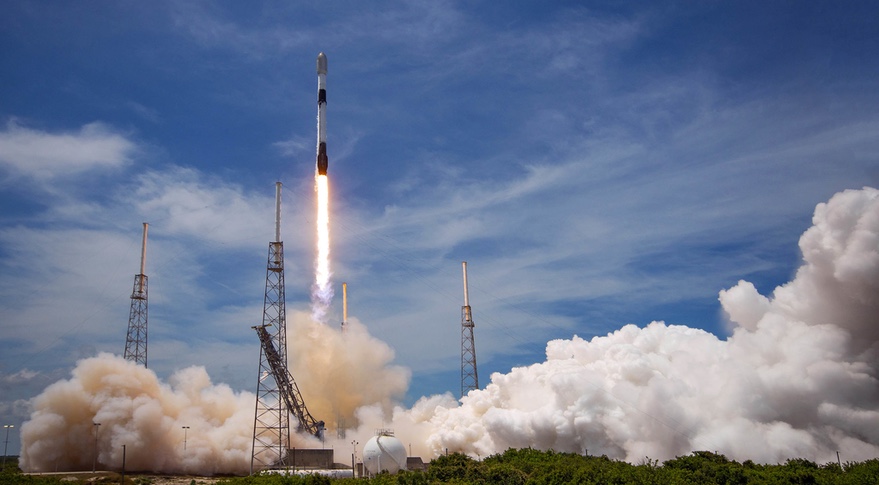 A SpaceX Falcon 9 lifts off May 25 on the Transporter-5 rideshare mission carrying 59 payloads. Credit: SpaceX
A SpaceX Falcon 9 lifts off May 25 on the Transporter-5 rideshare mission carrying 59 payloads. Credit: SpaceXLONG BEACH, Calif. — SpaceX launched several dozen payloads on its fifth dedicated rideshare mission May 25, illustrating the continued demand for such missions even as dedicated small launch vehicles emerge.
The Falcon 9 lifted off from Space Launch Complex 40 at Cape Canaveral, Florida, at 2:35 p.m. Eastern. The rocket’s booster, flying its eighth mission, landed back at Cape Canaveral’s Landing Zone One eight and a half minutes after liftoff.
https://spacenews.com/spacex-launches-transporter-5-dedicated-smallsat-rideshare-mission/SpaceX Launches Transporter-5 Rideshare , Wraps Up Multi-Mission Mayby Ben Evans May 25, 2022
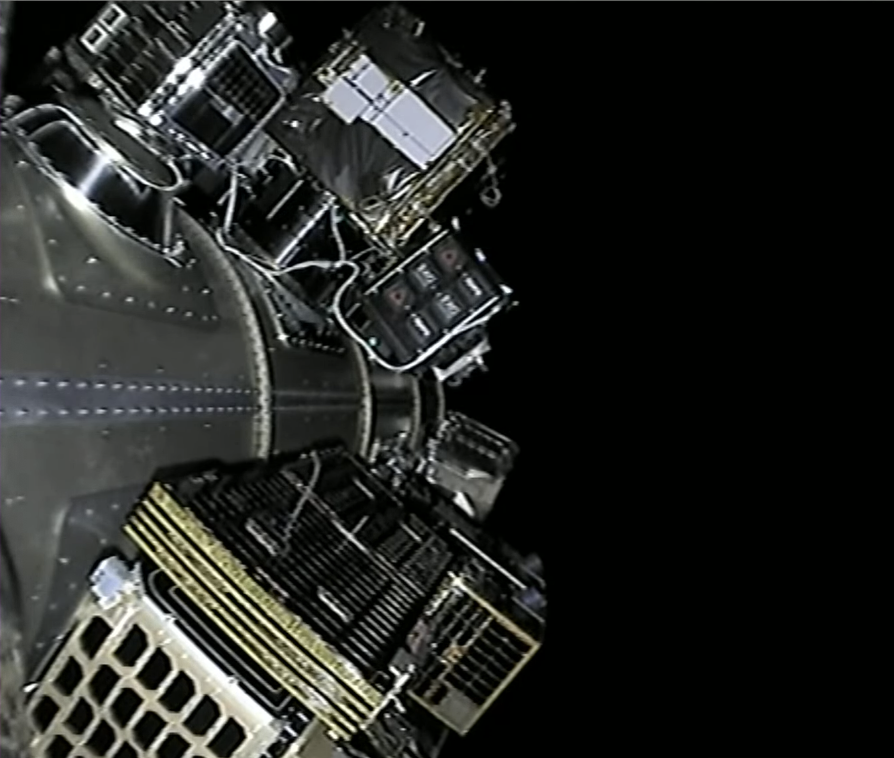 Today’s Transporter-5 rideshare included 59 discrete payloads, representating around a half-dozen sovereign nations. Photo Credit: SpaceX
Today’s Transporter-5 rideshare included 59 discrete payloads, representating around a half-dozen sovereign nations. Photo Credit: SpaceXSpaceX has successfully completed its third month to boast at least five Falcon 9 missions, as an eight-times-flown Falcon 9 booster speared aloft from storied Space Launch Complex (SLC)-40 at Cape Canaveral Space Force Station, Fla., at 2:35 p.m. EDT Wednesday. Laden with 59 small payloads, representing more than a half-dozen sovereign nations, and covering a smorgasbord of disciplines from Earth observations to technology demonstrations, from Signals Intelligence (SIGINT) to radio occultation and from education to a NanoRacks investigation to cut representative metal samples in support of future deep-space outposts, the mission wrapped up a banner fifth month of the year for SpaceX.
https://www.americaspace.com/2022/05/25/spacex-launches-transporter-5-rideshare-wraps-up-multi-mission-may/SpaceX launches fifth Transporter rideshare missionMay 25, 2022 Stephen Clark [SFN]
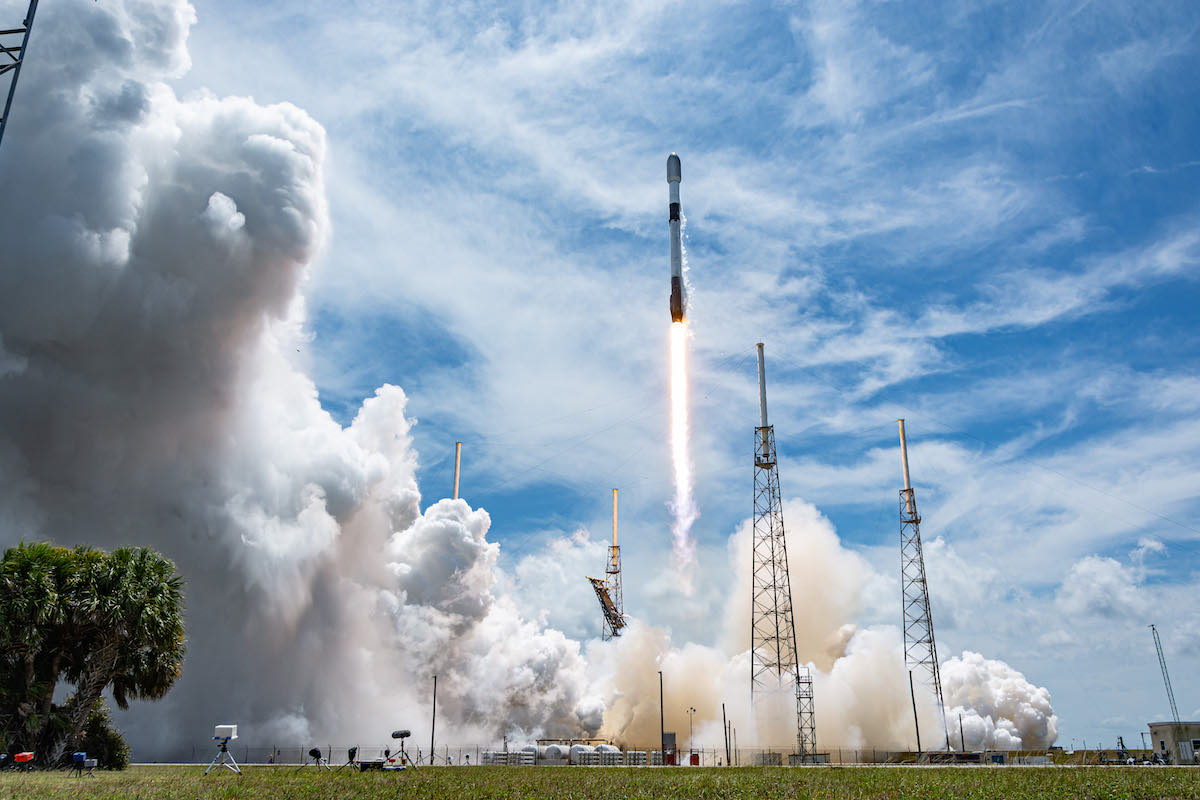 A Falcon 9 rocket lifts off on the Transporter 5 mission. Credit: Michael Cain / Spaceflight Now / Coldlife Photography
A Falcon 9 rocket lifts off on the Transporter 5 mission. Credit: Michael Cain / Spaceflight Now / Coldlife PhotographyA Falcon 9 rocket lifts off on the Transporter 5 mission. Credit: Michael Cain / Spaceflight Now / Coldlife Photography
SpaceX launched a Falcon 9 rocket Wednesday packed with 59 small satellites and research experiments, including an innovative commercial water-propelled orbital transfer vehicle from Momentus and a pair of NASA tech demos testing laser communications and proximity operations. (...)
After engine cutoff, a self-contained
payload from Nanoracks inside a box mounted on the upper stage was programmed to begin a 10-minute experiment to demonstrate metal cutting in orbit. The Outpost Mars Demo-1 experiment included three small coupons of corrosion resistant steel, which a robotic arm will attempt to cut using friction milling technology.
Nanoracks says the experiment is a first step in demonstrating metalworks in orbit, which could lead to advancements in space manufacturing and salvaging, including the conversion of used launch vehicle upper stages into orbiting habitats and research platforms.
The metal cutting experiment was expected to complete about 20 minutes after launch, then was supposed to downlink data and imagery to scientists through ground receiving stations.
 The Mars Demo-1 payload ready for launch on SpaceX’s Transporter 5 rideshare mission. Credit: Nanoracks
The Mars Demo-1 payload ready for launch on SpaceX’s Transporter 5 rideshare mission. Credit: NanoracksThe upper stage’s work wasn’t finished. Another engine firing occurred 55 minutes into the flight to place the satellite payloads into a near-circular orbit at an altitude of about 326 miles (525 kilometers), and an inclination of 97.5 degrees to the equator.
Then the Falcon 9 began releasing the rest of its commercial and government payloads.
The satellite passengers on the Transporter 5 mission included the
first Vigoride orbital transfer vehicle built by a startup named Momentus, which will demonstrate a novel water-based propulsion system.
There was also a
Sherpa transfer vehicle from Spaceflight, a company that specializes in brokering rides to space for small satellites, with its own roster of payloads. Another
orbital transfer vehicle from the Italian company D-Orbit also separated from the Falcon 9 upper stage to conduct orbital maneuvers before releasing multiple commercial smallsats.
“The orbital transfer vehicle that we call Vigoride is very versatile,” said John Rood, Momentus’ chairman and CEO, in a pre-launch interview with Spaceflight Now. “It can carry small satellites, cube satellites, nanosatellites, pico satellites, all simultaneously, and it uses a water-based propellant and microwave electrothermal thruster.”
Headquartered in San Jose, California, Momentus had to wait longer than it hoped to fly the the first Vigoride orbital transfer vehicle. An earlier version of Vigoride was originally slated to launch in early 2021. The U.S. government withheld regulatory licenses for the Vigoride demo mission, citing national security concerns stemming from the company’s original ownership by two Russian citizens.
The hold-up forced the Russian owners to divest their interest in Momentus, which is now a public company. Rood took the helm of Momentus last year, and the company secured U.S. government approval for the Vigoride demo mission.
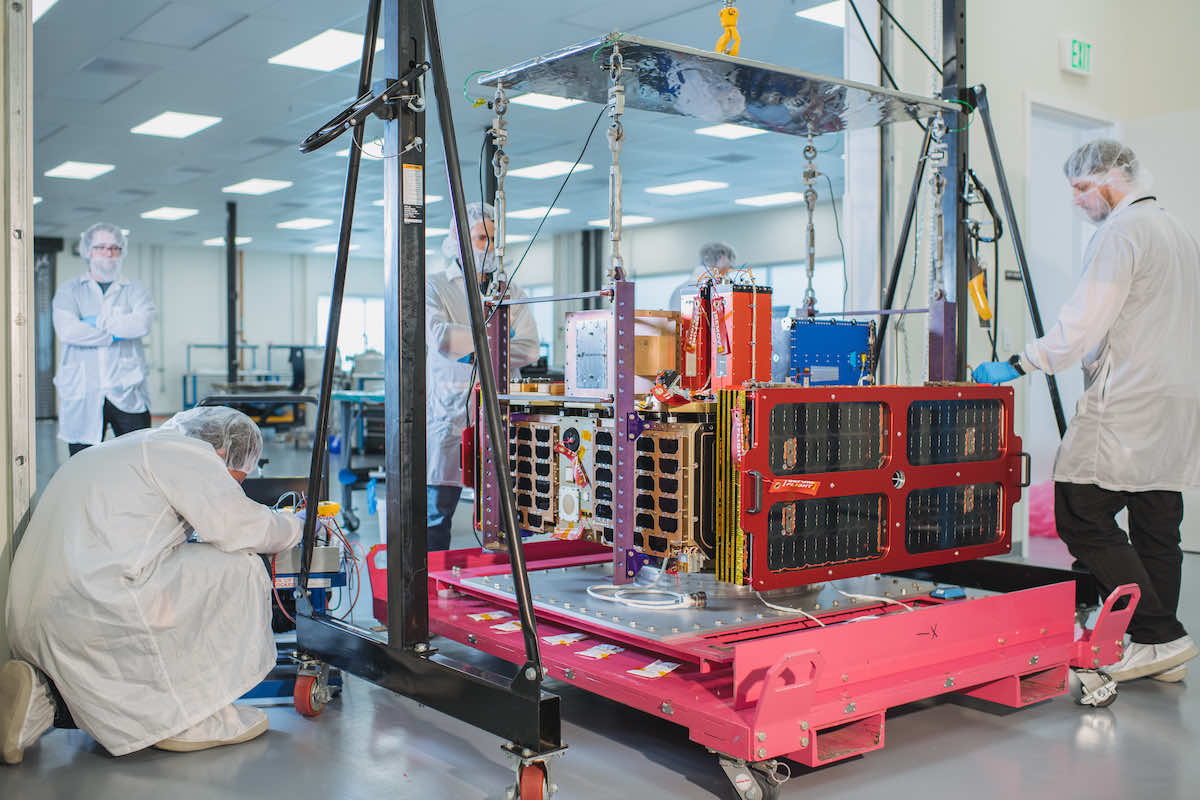 Momentus’ Vigoride orbital transfer vehicle. Credit: Niall David / Momentus
Momentus’ Vigoride orbital transfer vehicle. Credit: Niall David / MomentusMomentus’ orbital transfer vehicle is similar in purpose to space tugs developed by other companies, like Spaceflight and D-Orbit, both of which had their CubeSat carriers on the Transporter 5 mission.
The space tugs can change their altitude, inclination, or other orbital parameters, delivering small payloads to different locations in space than the drop-off orbit of the main rocket. The transfer vehicles can reposition small satellites into orbits more favorable for their missions.
Some transfer vehicles use conventional propulsion, with thrusters powered by liquid propellants. Others are testing electric thrusters, a lower-thrust but higher-efficiency propulsion option.
Rood said the water-based propellant used on Vigoride vehicle provides performance in a “sweet spot” between chemical and electric propulsion, with higher efficiency then conventional rocket fuels, and higher thrust the ion thrusters.
“It’s H20, it’s water as a propellant,” Rood said. “The way this works is similar to the microwave you use in your home. We use microwave energy with a magnetron to heat water vapor to a temperature that’s roughly half the temperature of the surface of the sun.
“The real science comes in to control that resulting plasma, making sure it doesn’t just melt through everything inside, including the nozzle,” Rood said. “And then controlling that plasma to expel it through the rocket nozzle to therefore produce thrust.”
The first Vigoride vehicle carries several customer payloads. The flight plan called for the transfer vehicle to deploy those small satellites, then begin orbital adjustments using its two water-fueled thrusters.
The Vigoride orbital transfer vehicle had an empty weight, or dry mass, of about 270 kilograms (about 600 pounds), according to Rood.
“This microwave electrothermal thruster technology has been in development since the 1980s by university researchers, but Momentus is a real pioneer in bringing it to the marketplace and using it in space.”
Momentus demonstrated a scale version of the thruster in 2019, but the propulsion system on the Vigoride transfer vehicle has many advancements over that test unit.
“This will really be the first full-scale usage of the technology in space,” Rood said. “We expect to learn a lot.”
Momentus also booked a port on the Falcon 9 rocket to accommodate customer payloads, which deployed directly from the upper stage in orbit.
Other payloads on the Transporter 5 mission included
five commercial ICEYE radar observation satellites, each nearly 200 pounds (100 kilograms) in mass. There were
four small optical Earth-imaging satellites from the Argentine company Satellogic, growing its constellation to 26 operational spacecraft. The Transporter 5 mission launched
three microsats from the Canadian company GHGSat, which is deploying a fleet of small satellites to monitor global greenhouse gas emissions.
There were also
three formation-flying spacecraft on the Transporter 5 launch for HawkEye 360, a U.S. company building a satellite constellation to detect and locate the source of terrestrial radio signals. HawkEye 360 said earlier this year its RF monitoring satellites detected GPS interference in Ukraine as Russian military forces invaded the country.
Umbra, a startup based in Santa Barbara, California, launched its third radar remote sensing satellite on the Transporter 5 mission. Another California-based company,
GeoOptics, also launched two small satellites for its commercial weather monitoring constellation.
There were
five Lemur 2 CubeSats on-board from Spire Global to track weather, aviation and maritime activity from space, support data relay services, host an optical payload, and test radio frequency detection technology for the UK Ministry of Defense.
The U.S. military’s Missile Defense Agency had two small tech demo spacecraft on the Transporter 5 mission to test inter-satellite communications links.
NASA had two CubeSat missions launching on the Transporter 5 mission.
One of the CubeSats is named PTD 3, developed at NASA’s Ames Research Center to host a laser communication experiment from MIT’s Lincoln Laboratory. The Terabyte Infrared Delivery, or TBIRD, experiment will test laser data links between a small satellite and a ground station, helping prove technology that could allow satellite networks to transmit vast volumes of data much faster than through conventional radio systems.
The other
NASA payload on the Transporter 5 launch was the CubeSat Proximity Operations Demonstration, which will demonstrate rendezvous, proximity operations, and docking using two shoebox-sized CubeSats.
One of the CubeSats on the Transporter 5 mission also carried the cremated remains of 47 people, part of a commercial memorial service provided by
Celestis. (...)
https://spaceflightnow.com/2022/05/25/spacex-launches-fifth-transporter-rideshare-mission/Momentus attempting to fix anomalies with first Vigoride tugby Jeff Foust — June 2, 2022 [SN]
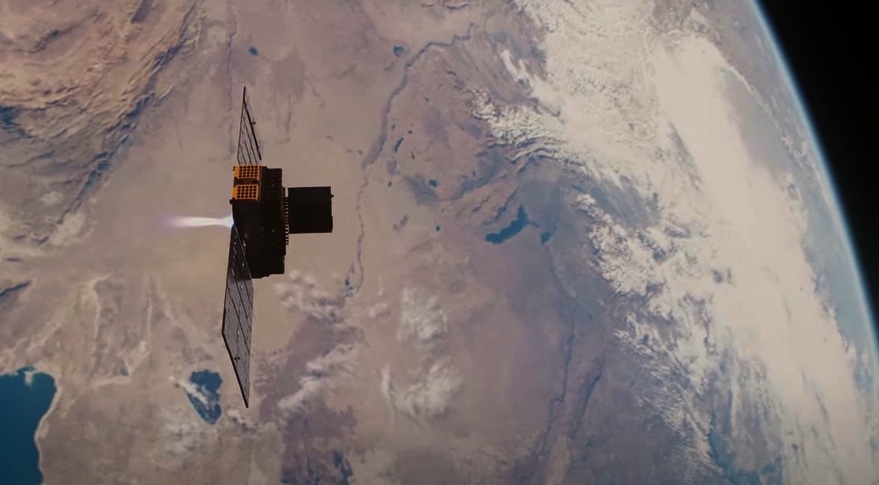 Momentus is attempt to fix "some anomalous behaviors" with its first Vigoride tug launched May 25, including a communications system tuned to the wrong frequencies. Credit: Momentus
Momentus is attempt to fix "some anomalous behaviors" with its first Vigoride tug launched May 25, including a communications system tuned to the wrong frequencies. Credit: MomentusWASHINGTON — A week after the launch of its first space tug, Momentus is still dealing with “anomalies” with the vehicle, but the company’s chief executive remains optimistic those issues will be resolved.
Among the payloads on the SpaceX Transporter-5 rideshare mission that launched on a Falcon 9 May 25 was Vigoride-3, the first tug developed by Momentus. The vehicle, primarily a technology demonstration mission, carried nine small satellites from three customers for later deployment.
https://spacenews.com/momentus-attempting-to-fix-anomalies-with-first-vigoride-tug/Globalstar spare satellite to launch on SpaceX rocket this monthJune 7, 2022 Stephen Clark [SFN]
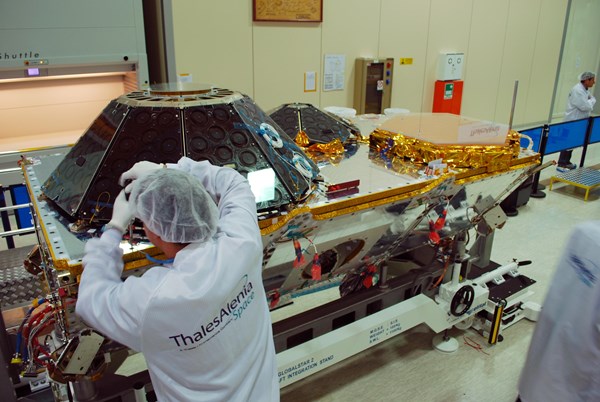 File photo of a Globalstar second-generation satellite. Credit: Thales Alenia Space
File photo of a Globalstar second-generation satellite. Credit: Thales Alenia SpaceA spare satellite for Globalstar’s data relay and messaging constellation will launch from Cape Canaveral on a Falcon 9 rocket later this month, multiple sources said, in a previously-undisclosed mission on SpaceX’s schedule.
The launch will be the first for a Globalstar satellite since 2013, and adds capacity for the company’s commercial network providing data connectivity for satellite phones, asset tracking, and internet-of-things applications.
https://spaceflightnow.com/2022/06/07/globalstar-spare-satellite-to-launch-on-spacex-rocket-this-month/SpaceX readies Falcon 9 rocket to launch Egyptian communications satellileJune 7, 2022 Stephen Clark [SFN]
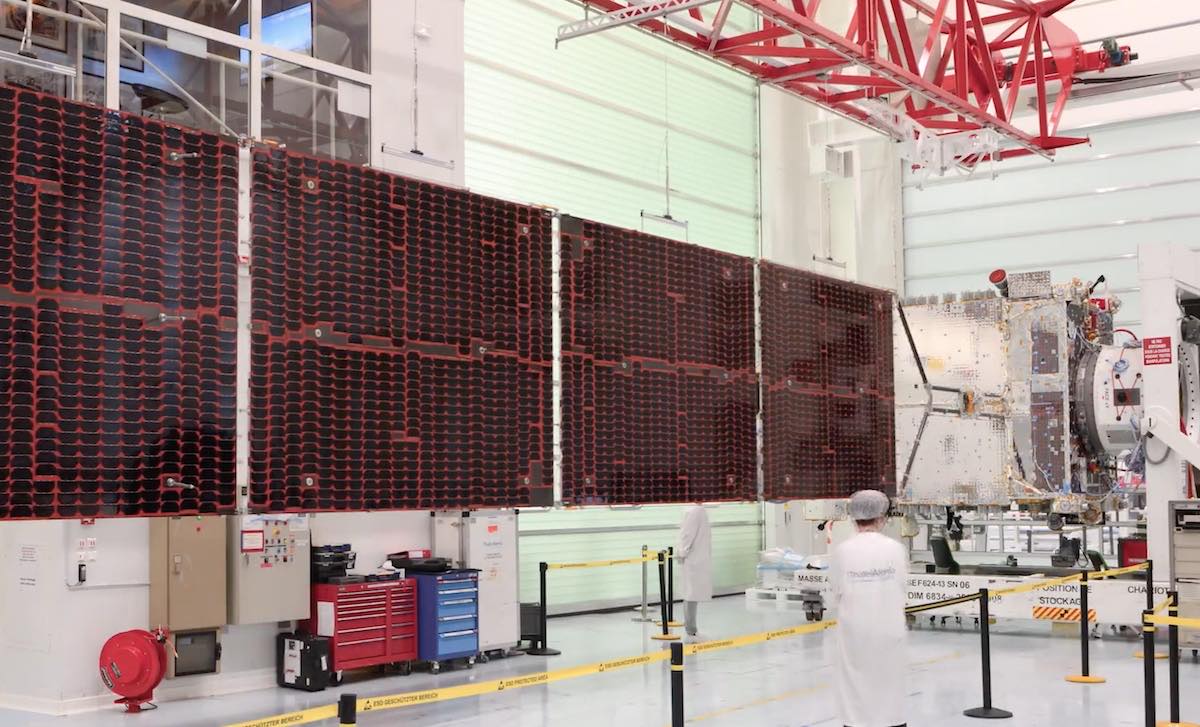 The Nilesat 301 communications satellite undergoes a solar array deployment test. Credit: Thales Alenia Space
The Nilesat 301 communications satellite undergoes a solar array deployment test. Credit: Thales Alenia SpaceAn Egyptian-owned communications satellite is nestled in the nose cone of a SpaceX Falcon 9 rocket for launch Wednesday from Cape Canaveral, heading for an orbital position more than 22,000 miles over the equator.
https://spaceflightnow.com/2022/06/07/spacex-readies-falcon-9-rocket-to-launch-egyptian-communications-satellite/SpaceX Launches Egyptian Satellite to Orbit, CRS-25 Stands Down Until 28 Juneby Ben Evans June 8, 2022
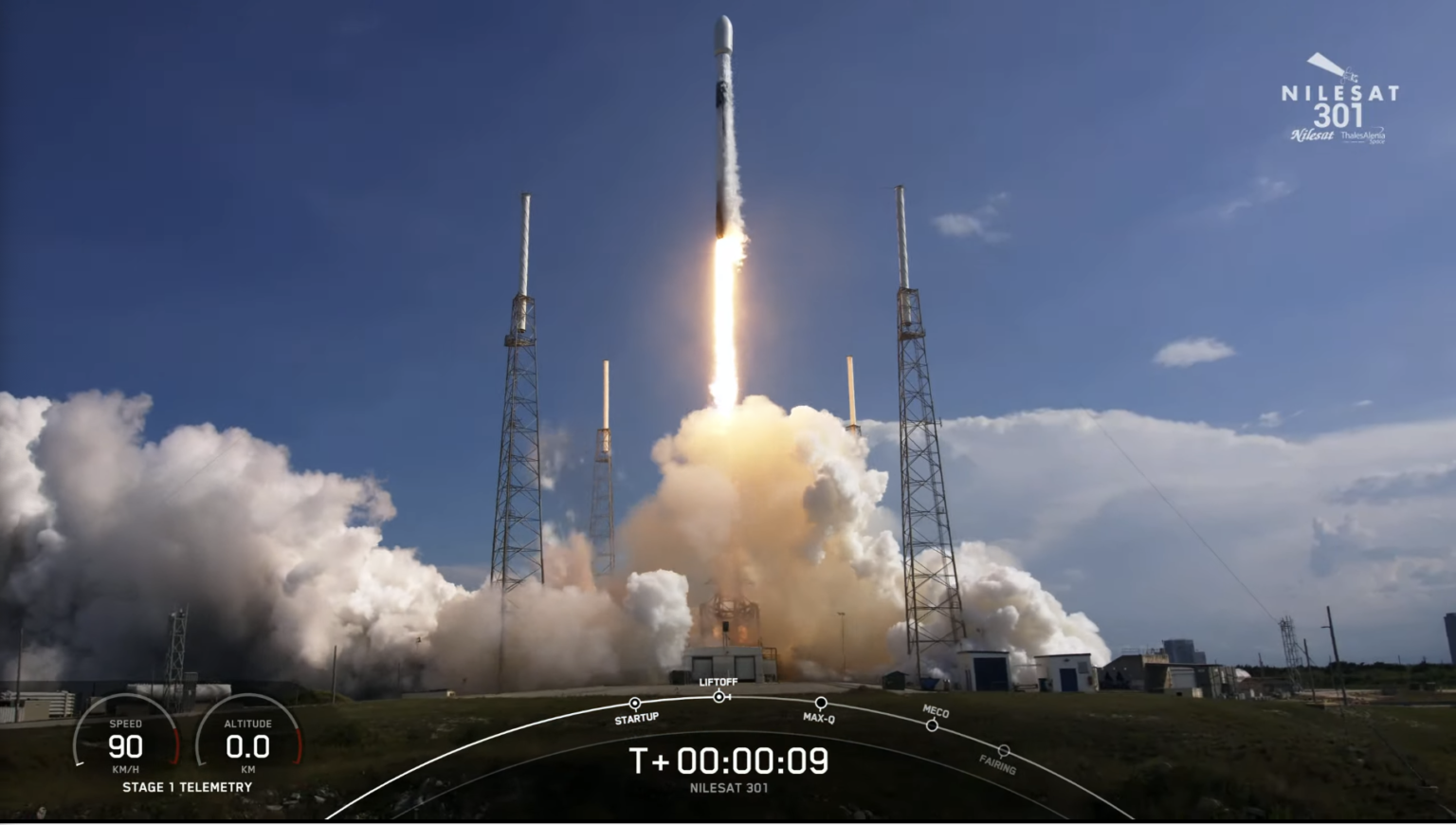 SpaceX’s first mission of June powers smoothly uphill at 5:04 p.m. EDT Wednesday. Photo Credit: SpaceX
SpaceX’s first mission of June powers smoothly uphill at 5:04 p.m. EDT Wednesday. Photo Credit: SpaceXA seven-times-flown Falcon 9 booster kicked off June in fine style on Wednesday, by delivering a powerful Egyptian communications satellite on the first leg of its uphill trek to Geostationary Transfer Orbit (GTO). Nilesat-301, set to be emplaced at 7.0 degrees West longitude for a minimum 15-year operational life span, rose from storied Space Launch Complex (SLC)-40 at Cape Canaveral Space Force Station, Fla., at 5:04 p.m. EDT.
https://www.americaspace.com/2022/06/08/spacex-launches-egyptian-satellite-to-orbit-crs-25-stands-down-until-28-june/SpaceX rocket hauls Egyptian telecom satellite toward geosynchronous orbitJune 8, 2022 Stephen Clark [SN]
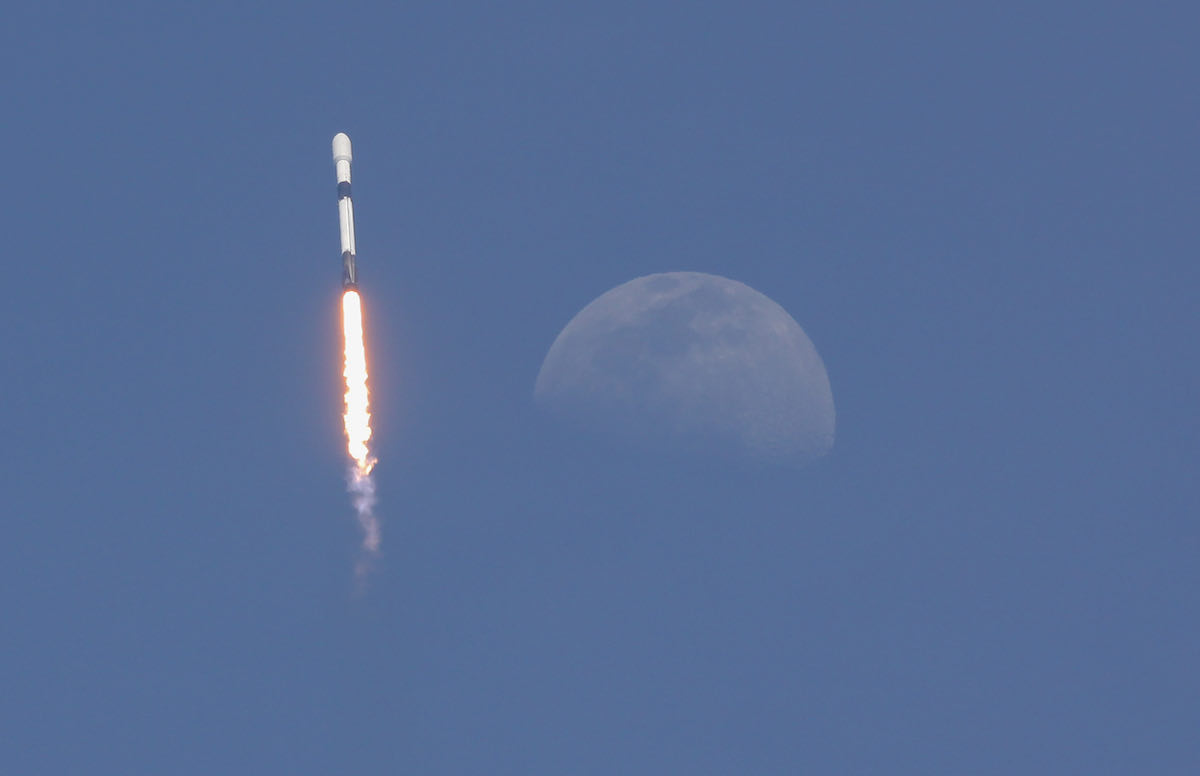 SpaceX’s Falcon 9 rocket dashes past the moon carrying the Nilesat 301 satellite into orbit. Credit: Stephen Clark / Spaceflight Now
SpaceX’s Falcon 9 rocket dashes past the moon carrying the Nilesat 301 satellite into orbit. Credit: Stephen Clark / Spaceflight NowSpaceX launched an Egyptian communications satellite toward a high-altitude geostationary orbit Wednesday from Cape Canaveral. It was the first commercial launch of a geostationary payload this year, another sign of a market shift toward smaller, lower-orbiting communications satellites. (...)
The launch Wednesday was the 23rd Falcon 9 launch of the year, and the first with a satellite heading toward geostationary orbit, a popular location for TV broadcasting and data relay spacecraft. It was also the first truly commercial launch into a geostationary transfer orbit worldwide this year.
The geostationary satellite launch market was once a lucrative business for launch providers, including SpaceX. But the satellite market has shifted to smaller spacecraft, including constellations flying in low Earth orbit, or LEO, to beam broadband signals to consumers.
Geostationary satellites are typically large and carry more communications capacity than a single LEO telecom spacecraft. In geostationary orbit, they orbit in lock-step with Earth’s rotation, allowing an antenna on the ground to point at the same place in the sky for a continuous link with the satellite. (...)
https://spaceflightnow.com/2022/06/08/spacex-rocket-hauls-egyptian-telecom-satellite-toward-geosynchronous-orbit/Egypt’s Nilesat 301 passes health checks after SpaceX launchby Jason Rainbow — June 9, 2022 [SN]
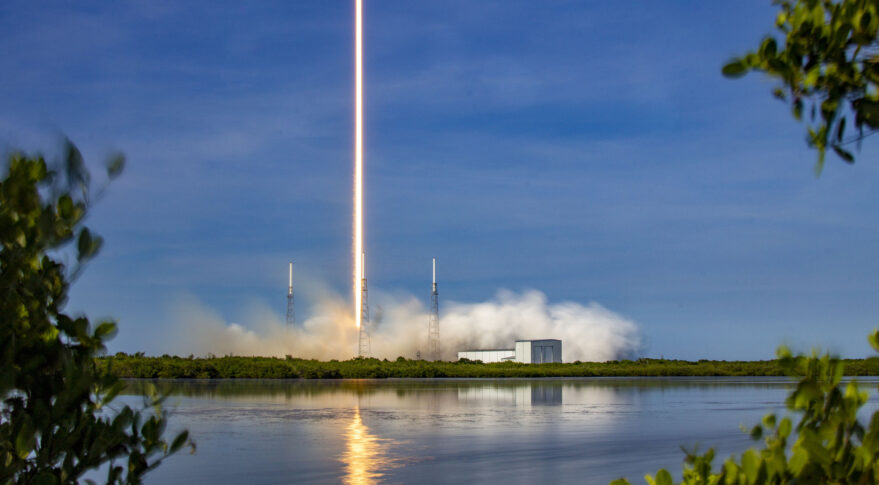 SpaceX launched Egypt's Nilesat 301 satellite June 8 on Falcon 9's 23rd mission so far this year. Credit: SpaceX
SpaceX launched Egypt's Nilesat 301 satellite June 8 on Falcon 9's 23rd mission so far this year. Credit: SpaceXTAMPA, Fla. — Egyptian operator NileSat’s latest communications satellite is ready to move to its final orbit after clearing health checks following its June 8 SpaceX launch, according to the spacecraft’s prime contractor. (...)
Based on Thales Alenia Space’s Spacebus 4000-B2 platform, Nilesat 301 carries Ku-band transponders for TV broadcasting and Ka-band capacity for internet services.
The satellite has a projected 15-year operational lifetime and will eventually replace the Thales Alenia Space-built Nilesat 201, which the Egyptian company expects will run out of fuel in 2028 after its launch in 2010.
In addition to covering the Middle East and North Africa (MENA) regions that Nilesat already serves with Nilesat 201 and other satellites it leases, the company said Nilesat 301 expands its reach into new markets in southern Africa and the Nile River basin.
Nilesat said Nilesat 301 also supplements connectivity services across Egypt and other countries along the Nile provided by Tiba 1, the Egyptian government’s first satellite that launched in 2019.
https://spacenews.com/egypts-nilesat-301-passes-health-checks-after-spacex-launch/BlueWalker 3 launch window opens Aug. 15by Jason Rainbow — June 13, 2022 [SN]
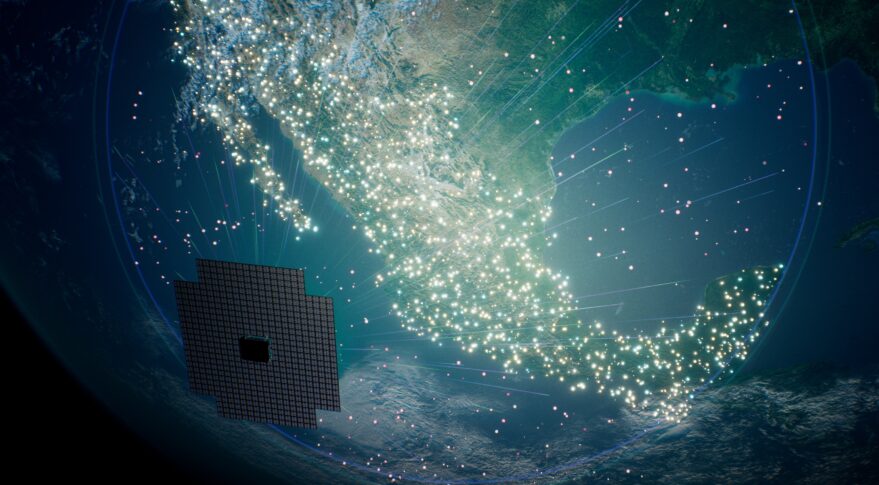 An artistic rendering of a BlueBird satellite. Credit: AST SpaceMobile
An artistic rendering of a BlueBird satellite. Credit: AST SpaceMobileTAMPA, Fla. — AST SpaceMobile said June 13 that SpaceX aims to launch the prototype for its cellphone-compatible broadband constellation in the week of Aug. 15.
The actual launch date is subject to final integration of the BlueWalker 3 test satellite, AST SpaceMobile added, and other factors including the SpaceX Falcon 9 rocket’s readiness and weather.
https://spacenews.com/bluewalker-3-launch-window-opens-aug-15/